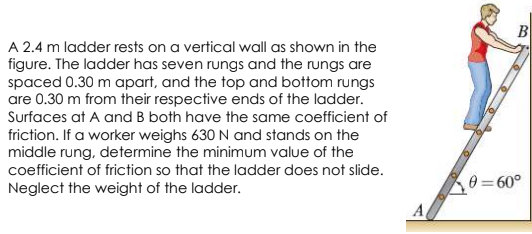B A 2.4 m ladder rests on a vertical wall as shown in the figure. The ladder has seven rungs and the rungs are spaced 0.30 m apart, and the top and bottom rungs are 0.30 m from their respective ends of the ladder. Surfaces at A and B both have the same coefficient of friction. If a worker weighs 630 N and stands on the middle rung, determine the minimum value of the coefficient of friction so that the ladder does not slide. Neglect the weight of the ladder. 0 =60° A
B A 2.4 m ladder rests on a vertical wall as shown in the figure. The ladder has seven rungs and the rungs are spaced 0.30 m apart, and the top and bottom rungs are 0.30 m from their respective ends of the ladder. Surfaces at A and B both have the same coefficient of friction. If a worker weighs 630 N and stands on the middle rung, determine the minimum value of the coefficient of friction so that the ladder does not slide. Neglect the weight of the ladder. 0 =60° A
Related questions
Question

Transcribed Image Text:B
A 2.4 m ladder rests on a vertical wall as shown in the
figure. The ladder has seven rungs and the rungs are
spaced 0.30 m apart, and the top and bottom rungs
are 0.30 m from their respective ends of the ladder.
Surfaces at A and B both have the same coefficient of
friction. If a worker weighs 630 N and stands on the
middle rung, determine the minimum value of the
coefficient of friction so that the ladder does not slide.
Neglect the weight of the ladder.
0 = 60°
Expert Solution
This question has been solved!
Explore an expertly crafted, step-by-step solution for a thorough understanding of key concepts.
Step by step
Solved in 5 steps with 1 images
